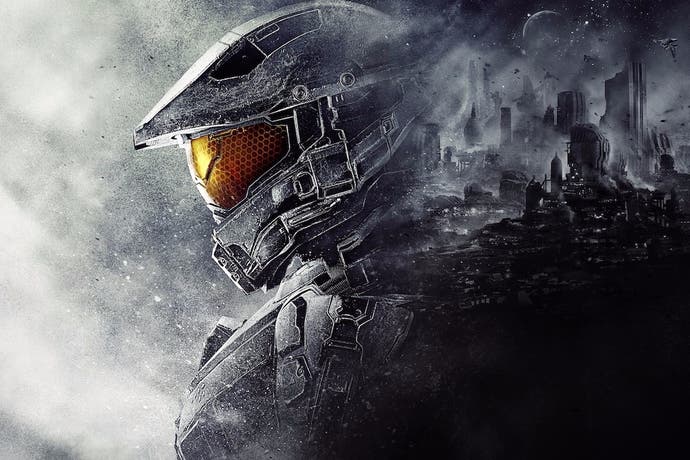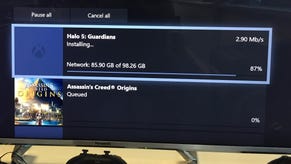Halo 5: Xbox One X's most impressive 4K upgrade?
The way it's meant to be played.
Step back for a moment to the year 2015. 343 Industries is releasing Halo 5: Guardians to eager fans the world over. While not completely escaping criticism, the game itself is well received and ultimately, it's a solid shooter with tight gameplay and gorgeous art direction - all delivered at a solid 60 frames per second frame-rate. However, that silky-smooth performance level came at a price: image quality. Xbox One just wasn't powerful enough to resolve everything the game had to offer, but with the release of Xbox One X, there's a strong argument that 343's vision is now fully delivered.
Welcome to the new face of Halo 5 on Microsoft's new six-teraflop console. The blurry mask is peeled back, revealing the full beauty of the original game. It's a revelatory improvement and the remarkable reality is that 343's 4K patch doesn't seem to offer huge improvements to core asset quality. There are some tweaks, improvements and refinements, but the fact is that by increasing resolution and texture filtering quality alone, the game is massively transformed, its inner beauty finally revealed.
In fact, the high resolution now reveals details which were once impossible to see. A case in point is the battle rifle - its rear-mounted display now resolves text detail right down to incidentals like the remaining battery life. It looks like the self-same artwork is used on the standard version of the game, but there simply wasn't the pixel real estate or the definition to actually see all of the intricate details. Perhaps more than any other game at the launch of the new Xbox, Halo 5 demonstrates just how much of an upgrade the hardware is capable of delivering, and while 1080p display users benefit, the 4K advantage is undeniable.
Which brings us to the key question then - just how much has the resolution improved and to what extent is 'true 4K' actually delivered? On the base Xbox One, Halo 5 is designed to target 1080p whenever possible but in reality, the game very rarely reaches this point. Nearly every single battle in the game plays out at lower pixel counts, even producing results as low as 810p at times. It's not optimal, but it made that perfect 60 frames per second action possible - a fair and logical trade-off.
On Xbox One X, the base resolution does indeed increase to a native 2160p or full 4K. Dynamic resolution scaling is still employed to ensure consistency in performance but this time, Halo 5 does a much better job in sticking closer to its optimal pixel count, with smaller skirmishes and less crowded areas all delivering native 4K. In terms of pure compute power, Xbox One X has a 4.6x advantage over the launch version of the older system and you get all of that scalability transferred into raw pixel count in Halo 5 - and more. In fact, in like-for-like scenarios we've seen anything up to five or even six times the resolution on Xbox One X. Engaging the new system's GPU power and its prolific leap in memory bandwidth, the leap is tremendous.
In terms of dynamic resolution scaling metrics, Halo 5 still adjusts the X and Y axis independently, resulting in some oddball values. This includes resolutions such as 2816x1584 and 3360x1890. From a normal viewing distance and during the heat of action, however, these drops are difficult to notice. The perception during play is that Halo 5 is now a razor-sharp experience, more worthy of your display, whatever resolution it may be. Yes, Halo 5 is at its best on a 4K TV, there's no doubt about it, but owners of 1080p displays benefit greatly as well.








There are two reasons for this and it applies to a great number of games available for the system. First and foremost, the Xbox One X down-samples everything automatically, so you can count on improved, super-sampled image quality on your TV display. But the most important thing to consider is this: Halo 5 and many other Xbox One games fail to reach 1080p much of the time. If you're playing Halo 5 on an Xbox One on a 1080p TV, you're still getting sub-native image quality throughout. On Xbox One X, however, just the bump to 1080p offers a huge improvement but super-sampling takes things beyond that even.
And this brings us to the second reason - texture filtering and by extension, unpatched image quality. As we highlighted in our Xbox One X review, prior to the launch of the system, we tested Halo 5 on the system without the 4K patch installed and the dynamic scaler still takes advantage of the faster hardware automatically. This means that Halo 5 runs at a full 1080p without any additional patching right out of the box. It demonstrates the flexibility of the renderer when coupled with more powerful hardware - and the X hardware enforces 16x anistropic filtering on top of that.
With the 4K patch installed, texture filtering is greatly improved over the muddy ground textures of the base Xbox One, allowing detail to be preserved further into the distance. However, the enforced 16x AF in the unpatched code actually resolves more detail than the 4K patch in some areas. Clearly, the massive bump in resolution leaves fewer resources for high quality texture filtering and the 16x AF had to give. It's still a huge improvement either way, but the results on Halo 5 before 343 got to grips with the new hardware are certainly fascinating. Clearly though, given the choice, we'd go for the 4K patch.








There are improvements beyond resolution and filtering too, with 343 making strategic upgrades that vary in scale. The text and surrounding elements are all recreated at native 4K, meaning that everything from your in-game HUD to the various menus throughout the game are improved and sit nicely on an ultra HD display. There's also evidence to suggest that 343 has made some subtle boosts to level of detail settings - in one area, more debris resolves on the ground, while in cutscenes, draw distance on incidental detail is pushed further into the background.
Beyond these changes, Halo 5 retains many of the same performance-saving techniques present in the original release. Considering this is a patch produced two years after launch, this is fully expected. Animation still plays at half-rate when enemies are at a distance or when the battlefield becomes too crowded - a factor of CPU time remaining relatively limited, even on Xbox One X. Shadow quality also remains inconsistent at times with alpha effects, such as fire, removing them from view to avoid overdraw, just as we saw in the original release. It would have been great to see these issues addressed but again, it's not unexpected since it is an incremental upgrade - not a revamp of the entire engine.
Thankfully, even with the massive jump in pixel count, Halo 5's adaptive resolution feature remains as effective as ever. During our time with the game on Xbox One X, we played through a chunk of every single mission in the game and never once encountered any actual GPU-related drops in performance. Everything was smooth and stable, just as you'd hope. Our focus during the title's 2015 debut concerned the compromises 343 made in delivering that exceptional 60fps experience - the good news is that 343's dedication here has not wavered.
The one caveat to keep in mind though concerns occasional loading hitches. As with every other game in the series, Halo 5 regularly fetches data from the hard disk to provide a more seamless experience and that remains the case here. When moving between areas or travelling at a high speed, you'll still run into occasional hitches and blips. Our advice here? Run the game from the internal drive - it cuts down the impact of the pauses, though it can't remove them completely.
The bottom line is that Halo 5 on Xbox One X is an excellent upgrade. There is a sense that the original artwork crafted for the game was never fully visible on an original Xbox One and with Halo 5 only existing in a limited form on PC, there's a good argument that we never got to play the entire game in the way it was meant to be played. The bottom line is that with Xbox One X, now you can. If you missed out on Halo and can accept that this is a vision unique to 343 Industries, rather than a Bungie-style offering, it's absolutely worth a look.
And this is only the first step in upgrading the overall Halo experience for Xbox One X. The Master Chief Collection is slated for upgrades early next year, while owners of the original Xbox 360 version of Halo 3 can already enjoy it at a much higher resolution with HDR enabled - a superb spin on Xbox 360 backward compatibility, and something we'll be looking at in more depth soon. Combine all of this with the native 4K patch for Halo Wars 2 that's also available now and it's clear that Microsoft and 343 are fully engaged in getting the most out of the Master Chief's library titles for its shiny new console. Now, how about a 4K HDR upgrade for Halo Reach?











